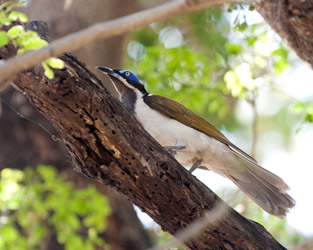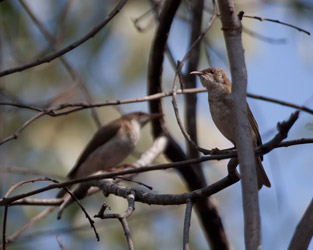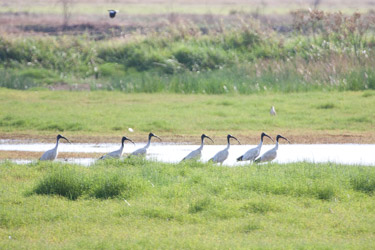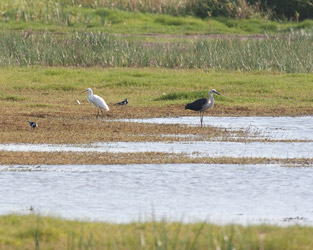To Townsville
Thursday, October 15, 2009:
We left the hotel at 5:30 to catch our flight to Townsville. It ended up being delayed about half an hour. Once we got our luggage, we stepped out into the tropical climate of Townsville. It felt a lot more like home! In fact, it looks a lot like home too. As in many developed areas in the tropics, they use many of the same tropical landscape plants that we use in Miami.
The change of location made it easy to find new birds. Most of us got two lifers as we were waiting to put the luggage in the bus—White-breasted Woodswallow and Torresian Crow.
After leaving our luggage, we made a check of the hotel grounds. This added a few more birds—Brown Honeyeater, Peaceful Dove, Australasian Figbird. and White-gaped Honeyeater. I later found an active Brown Honeyeater nest near the swimming pool.
A short walk to the beach added a beautiful Brahminy Kite, along with Mangrove Honeyeater, Gull-billed Tern, Whimbrel, and Little Tern. We also found a Common Brushtail Possum, Trichosurus vulpecula, up in a palm tree.
 |
 |
| Braminy Kite | White-breasted Woodswallows |
We then got in the bus and went to lunch. Our rooms were ready when we got back. After getting settled, we headed out in search of more birds. Our first stop was a place Jeri knows that has previously had a bowerbird bower. There was a lot of bird activity there! We quickly picked up a bunch of Rainbow Bee-eaters. As the bee-eaters were putting on a show, someone noticed a Blue-faced Honeyeater in the tree above us. But we could only briefly look at that because of Great Bowerbirds across the field. Brush Cuckoo soon appeared in the same tree. We inspected the bowerbird bower, and found that a Little Bronze-Cuckoo was in the tree with the Brush Cuckoo. But what about the Bush Stone-Curlews? While getting a better look at them, still more birds appeared. A Pacific Baza flew over, as did an unidentified friarbird. Finally, a White-throated Honeyeater showed up in the same trees across the grassy area that had produced so many birds. Apparently one of the trees was full of caterpillars, which attracted the birds.
 |
 |
 |
| Blue-faced Honeyeater | Rainbow Bee-eaters | Little Bronze-Cuckoo |
 |
 |
 |
| Bush Stone-Curlews | Brush Cuckoo | Brown-backed Honeyeaters |
Next was the Town Commons Conservation Park, where we stopped first to check the water (reduced this year due to drought). Red-tailed Black-Cockatoo was seen on the way, and Brown-backed Honeyeater near the parking lot. The water held Straw-necked Ibis, Intermediate Egret, and Eastern Great Egret. Black Kite worked the fields. We also found Varied Triller and Yellow Honeyeater in the woods. The wallabies also deserve a mention.
 |
 |
| Leaden Flycatcher | Allied Rock-Wallby |
 |
 |
| Black Kite | Yellow Honeyeater |
Our next stop, with a tower and more water, produced Black-necked Stork, White-necked Heron, White-headed Stilt, Little Egret, Brolga, Australian Bustard, Cattle Egret, Whistling Kite, and Australasian Pipit. We also got to study the ferocious Green Ants that build nests in trees.
 |
 |
 |
| Australian White Ibises | Black-necked Storks | Waders |
 |
 |
 |
| Heron and Egret | Brolgas | Red-backed Fairywren |
 |
 |
 |
| Brown-backed Honeyeater | Goanna Fight | |
The plan was to drive further to a hide (Aussie for blind). However, birds distracted us along the road. We found Red-backed Fairywren, Olive-backed Sunbird, White-shouldered Triller, Bar-shouldered Dove, Nutmeg Mannikin, and Zitting Cisticola on the way. Before we got to the blind, we also encountered two large monitors fighting. We watched for some time. It was an amazing struggle, mostly wrestling, with some biting and clawing. Eventually, they broke off, with one running away.
 |
 |
 |
| Whistling Kite | Australian Pelicans | Australian Bustard |
We continued to the blind. Australian Brush-turkey was first seen near the blind. More waders were visible from the blind. Royal Spoonbill was in the water, and there was a kettle of kites, pelicans and others overhead. We saw both Australian Bustard and Pheasant Coucal on the road on the way out.
Trip total—142 species including 131 lifers. Two wallaby species and a possum brought the mammal total to 7.
Seagulls Resort on the Seafront, Townsville